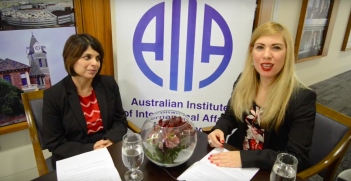The Politics of the Two Ocean Navy

The Two Ocean Navy policy of 1987 was arguably the boldest shift in force posture made by Australia since the Second World War. In a rare insight into how this came into being, security analyst Serge DeSilva-Ranasinghe interviews Kim Beazley, the policy’s chief architect.
Serge DeSilva-Ranasinghe: To what degree did historical considerations play a role in formulating the Two Ocean Navy policy?
Kim Beazley: Historically, a lot. The focus of British admirals has always been the Indian Ocean. The context that mattered, back in the day, were the lines across the Indian Ocean to the Suez Canal or around South Africa. The American perspective has always been the Pacific but the British perspective has always been the Indian Ocean.
Serge DeSilva-Ranasinghe: Did you have to increase the defence budget to accommodate the Two Ocean Navy?
Kim Beazley: You’d certainly have to reprioritise. In those days, back in the 1980s, our spending on defence was well over two per cent of GDP, so it was a much bigger proportion of the budget. I can actually remember a budget when education spending was behind defence and health spending only just ahead. Things have changed dramatically since then, but it was a big percentage of the budget back in the 1980s. So yes, it was expensive. Stirling was just a forward base, so we had to build accommodation there. We had to build better roads, we had to build a submarine training school, a dive tower; there were a load of things we had to spend on. But actually it was probably cheaper to spend on those things there than to spend in Sydney. Of course Sydney already had an infrastructure but it is not an easy place to sustain a base. It’s an expensive city. You’ve got security issues and you’ve got clashes with civilian use of the waterways. Stirling’s a much more secure base.
Serge DeSilva-Ranasinghe: Do you think that the Two Ocean Navy has resulted in the original outcomes you envisaged back in the 1980s?
Kim Beazley: Absolutely. [HMAS Stirling is] a much more effective location for the deployment of submarines and I think it would be likewise for surface vessels. It was tectonic, but the strategic argument was so overwhelming that the personal arguments and sadnesses, you could see that they understood that they couldn’t hold sway. If you’re going to defend the country, you have to do things differently. Almost as tectonic as that was shifting the Army to Darwin. No matter what complaints you might have had about whether your spouse could find work in Western Australia and that sort of thing, that was a much greater consideration with Darwin because it’s a much smaller place. Perth was a modestly sizable city then and it’s quite a sizeable city now at 1.8 million people. You could at least see the sort of lifestyle that folks would want was more or less available in Western Australia, but was not at all available in Darwin.
Serge DeSilva-Ranasinghe: How relevant do you think the Two Ocean Navy is today, with the nature of homeland security and non-state aggression?
Kim Beazley: The non-state threats are important, but we live in a part of the world where the Treaty of Westphalia still counts. We live in a part of the world where national sovereignty is the key. We live in a part of the world where, as wealth grows and therefore budgetary capacities grow, states in the region are moving away from defence forces organised around internal security to defence forces organised to deal with issues in the approaches. We’re one part of the globe where no maritime boundaries are settled, really. Where capacity’s growing exponentially, and when anyone in our region plans defence forces, while they have to deal with criminal and counter-terrorist issues, they think in inter-state terms—more than Europeans do, for example. So I don’t think, what you might call modern defence and security issues, take away from the older traditional factors when you look at our defence needs. You have to drive your defence policy with the realities that you live with, not the realities that some other people live in. The realities we live in are very much the realities of classic nation-state formation and potential conflict.
Serge DeSilva-Ranasinghe: The Navy presence in the west is widely seen as a key element of developing closer support with the US. How much was this considered as a potential side benefit of a Two Ocean Navy at the time and was there any US support for developing Stirling?
Kim Beazley: There was a lot of support there from the United States. In those days the Americans used it a bit more heavily than I think they do now. Back in the 1980s there would be an American submarine berthing at Stirling every couple of months. In fact the Navy, in the only place in Australia where this applied, had its own tugs in Western Australia in order to be able to berth the American nukes. Likewise we had more visits by American carrier battle groups. The Americans have gotten much more antsy in the northern Indian Ocean, and they stay on station much longer in that area now than they did in the 1980s. So paradoxically, that means they are using Australia less and less compared to those days. They still do, but compared to then not as much. The Americans were keen on seeing Stirling upgraded because their submarines, at least, would use it quite a bit. Whether they do again in the future one doesn’t know. On the other hand, they’re interested in the deployability across the north of aircraft as well as men. So if you look at the facilities they are at the moment most focused on, it’s more the air bases than the facility at Stirling. That’s under study.
Serge DeSilva-Ranasinghe: How would you describe WA’s strategic importance to Australia, looking back through the course of the 20th century and up to today? Where do you think it’s likely to head in the decade ahead?
Kim Beazley: The importance to our economy of our northern minerals and energy provinces is much greater than when I was younger. The first study I saw that really made big points about that was the Smith-Hawke study. It featured in the last Defence White Paper as well. Western Australia is much more important to Australia now than it was when I was defence minister. I think the focus on Western Australia and the north will grow. Of course, good defence actually doesn’t recognise state boundaries, it only recognises a continental national entity.
The Hon Kim Beazley AC FAIIA is the national president of the Australian Institute of International Affairs and former Australian ambassador to the United States. He is a former politician and has served as minister for defence, deputy prime minister of Australia, leader of the Labor Party and opposition leader.
Th interviewer Serge DeSilva-Ranasinghe is a security analyst, defence writer and consultant. He is also an associate of the Australian Risk Policy Institute; adjunct scholar with the Centre for Independent Studies; research fellow with the Perth USAsia Centre, University of Western Australia; fellow of the National Security Institute, University of Canberra, and a fellow with the Institute For Regional Security.
For a full transcript of the interview published by the Australian Navy Institute click here.





